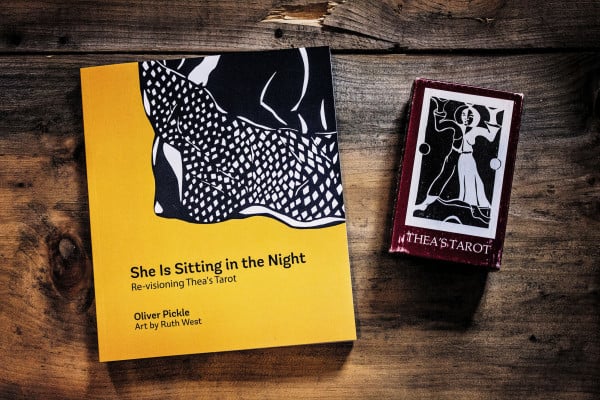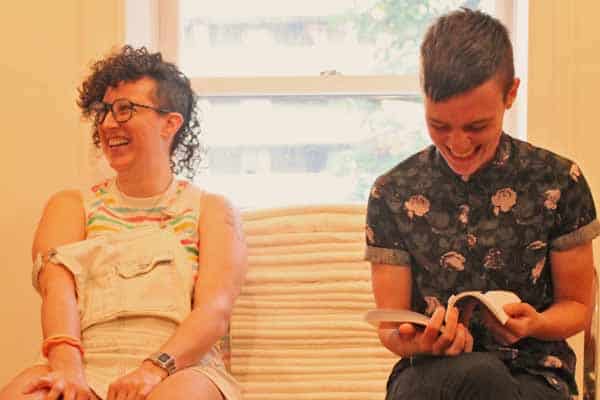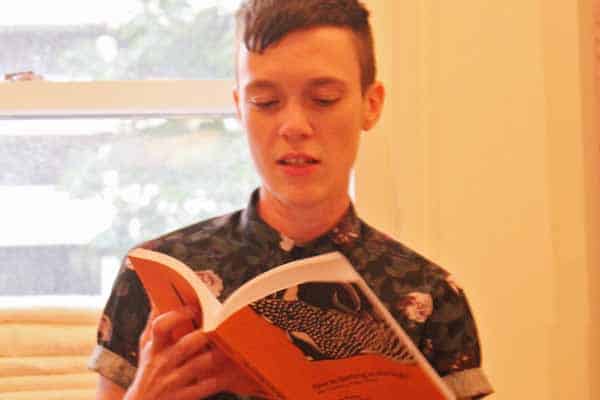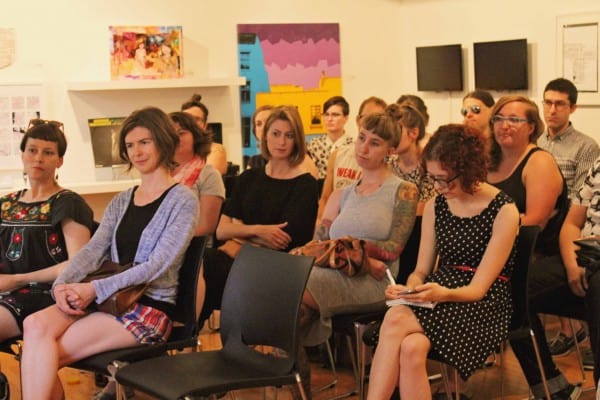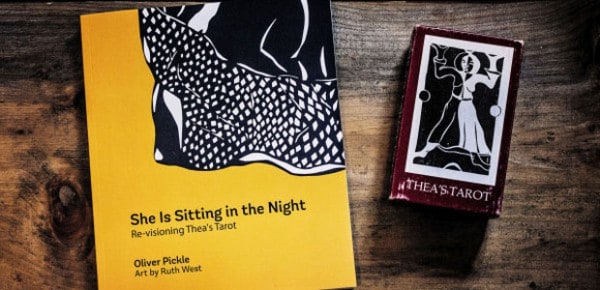 On 9 July 2015, Montreal’s Metonymy Press, along with Toronto’s Canadian Lesbian and Gay Archives (CLGA) celebrated the Toronto launch of Oliver Pickle’s She is Sitting in the Night: Re-visioning Thea’s Tarot.
On 9 July 2015, Montreal’s Metonymy Press, along with Toronto’s Canadian Lesbian and Gay Archives (CLGA) celebrated the Toronto launch of Oliver Pickle’s She is Sitting in the Night: Re-visioning Thea’s Tarot.
Rima Athar — a friend of Pickle and key actor in the She is Sitting in the Night project — knew that the tarot was a tool used to explore human and personal experience. However, she was frustrated with imagery which reflected “hierarchical European monarchies, […] themes of conquest and war, dogmatic Christian religious orthodoxy, and moral overtones.”1 Hungry for alternatives, she began her online search for an explicitly lesbian-feminist tarot deck. She found herself stumbling down a digital rabbit hole, and lucky enough to discover Thea’s Tarot: a now out of print deck self-published by Ruth West in 1984. An email address for West found in an old message board thread was her golden ticket; she got her tarot cards, the chance to talk with West, and the idea to invite queer author and tarot reader Oliver Pickle to engage with a piece of lesbian-feminist history which created feelings of desire and anxiety within them both.
She is Sitting in the Night traces the history and contemporary legacy of Thea’s Tarot; a deck named for the Greek for word for goddess, but also for West’s cat whose image appears alongside the goddesses, amazons, and women in love pictured throughout the deck. More than a history project, the book also captures the intergenerational dialogue of Athar, Pickle, and West. Included is a forward by Athar which tells the story of West’s Thea’s Tarot (often in the artist’s own words) and an introductory essay and interpretive notes written by Pickle. The majority of the book is comprised of reprints of the cards and Pickle’s expanded interpretations of them — the original deck only included short one line descriptions — that are geared at a more contemporary politics.
The highlight of the launch included a conversation between Pickle and friend Marty Fink. The two friends, slightly awkward and nervous, but filled with laughter and understanding, talked their way through a conversation about Oliver’s relationship to tarot and the logistics of the project. At one point Fink drew a card from the deck and had Pickle read from the book. As Fink drew the Tower, we all heckled a bit at the supposed doom of the card, but our laughter grew more quiet as Pickle read: the descriptions are a mix of charm, thoughtfulness, and humour which make for an insightful, meaningful, political, but also sometimes very light hearted read.
Copies of the new book were for sale, as well as a few of the original hard to find and out of print decks. While the details around the sale of Thea’s Tarot decks are fuzzy, there may still be some stock hiding out there, so a re-print of the deck is not yet in the works. She is Sitting in the Night is available for sale on the Metonymy Press website and at select independent booksellers.
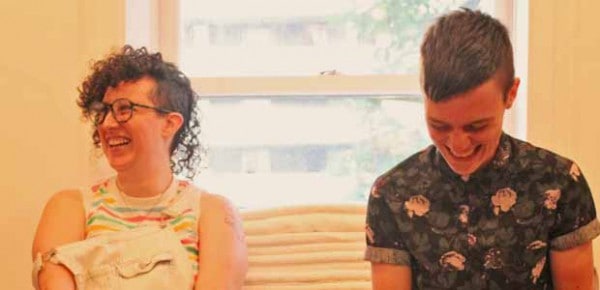
While She is Sitting in the Night is a contemporary project geared at queer audiences — and the packed crowd at the CLGA reflected this — it is dependent on histories of feminist spiritual and cultural activism occurring from the 1970s onwards. After graduating from college near the end of the ’70s, Ruth West found herself surrounded by the feminist arts movement; do-it-yourself and women run projects like artist centres and publishing houses were changing the cultural landscape for lesbians and feminists by allowing the production of objects outside of mainstream hetero-sexist contexts. At the same time, feminists were beginning to question the patriarchal structures of religion and explore new occult paths.
Inspired by both of these movements, around 1980 West began her work on Thea’s Tarot: thinking through card descriptions, turning them into large-scale black and white paper cut designs, photographing and then photocopying the art down to size. The deck is inspired heavily by Billie Potts’ A New Women’s Tarot, a pamphlet self-published in 1977 that rewrote traditional tarot with feminist matriarchal imagery and symbols. Just like Pott’s version of the tarot, in Thea’s Tarot the Page becomes the Child, the Knight becomes the Amazon, the Queen becomes the Daughter, and the King becomes the Mother; this was a means of doing away with patriarchal images of war and conquest, such as the King and the Knight.
These are not your typical cards; some are, in the words of Pickle, “really gay.” The Lovers are two nude women who lay collapsed in ecstasy. The Two of Cups depicts a charming pair in slacks and plaid who hold hands and appear to be destined for a lovely shared experience (one holds two goblets, the other a pad and pen). goddesses, priestesses, amazons, and wild women of all shapes and sizes grace the cards. Feminist politics that encouraged diversity in representations of women also influenced West’s designs, as the bodies depicted in the deck vary in size, looks, and hairstyles. Egyptian, Native American, and Celtic figures appear in the images: West’s attempt to include, rather than appropriate, cultural styles. However, not all the traditional imagery is stripped from the deck: card suites and some symbols still remain intact.
What, then, does Pickle’s project do? Much like West, Pickle spent time working daily with the deck and writing expanded descriptions of each card. Under the encouragement of Athar, the all-woman deck took a more inclusive spin. Pickle rewrote the descriptions to include not only the female-identifying pronoun of she, but also the gender-neutral pronoun they, and consciously made an effort to not code all seemingly “femme” cards as women. For contemporary queer communities, the separatist, women-only politics of previous generations of activists like West are problematic as they tend to exclude trans and gender nonconforming individuals. Despite their issues, this doesn’t mean that these histories don’t have meaning and value in the present.
After the conversation between Fink and Pickle, hands slowly shot up to pose questions ranging from the personal, “What’s your favourite card?” to the political, “Why do queers love tarot?”
As things wound down, I was lucky enough to get a short one-card reading from Pickle. I clumsily shuffled the deck amidst the chatty crowd in the small second floor gallery of the CLGA, dropping one of the cards in the process. Pickle explained that usually they’d read this card alongside the others; in this case, the single card that I pulled from the deck. This card was the Sun: representative of joy and happiness. A person with full cheeks and a lion’s mane of feathery hair supports herself on her hands, looking up at the viewer. The card that I dropped was the Nine of Pentacles, which Pickle told me symbolized acknowledging the good in one’s life: seeing something you’ve created, the sacrifices along the way, and in turn recognizing it’s value. The figure in the Nine of Pentacles lays on a couch, book in her hand, and cat at her feet; relaxing and reflecting. I felt the reading was relevant and important for me at that time.
The book ultimately reflects Pickle’s own practice as a tarot reader: these descriptions are of West’s cards, but they come from the mouth and mind of Pickle who has been reading tarot in Montreal for somewhere between five and seven years; some might call it community service.
Queers who come for readings I do are often either wanting relationship guidance or aiming to be self-reflexive. Tarot seems to provide a container for self-analysis and guidance that people can get behind, and it works for people who are invested in other therapeutic or spiritual frameworks as well as those who are squeamish about that kind of imposed structure. Because tarot can be participatory, it leaves a lot of room for self-determination, which is empowering and valuable.
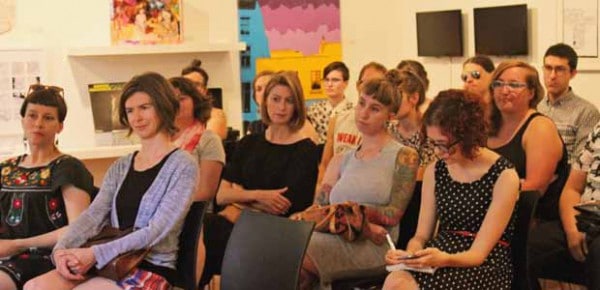
When asked if the deck might be of value to those who don’t identify as queer or associate themselves with a queer politics, Pickle replied:
While there are some overtly queer terms used in the book, and while it has queers as its primary audience, I think anyone who is thinking about mutual aid, power, and community, for example, could get something out of this book to support their healing and growth. This analytical lens can definitely be applied when using other decks for readings as well.
She is Sitting in the Night captures not only a snapshot of a moment in time — the deck that Ruth West crafted in 1984 and the community and ideas associated with it — but also forms a picture of intergenerational dialogue. In many ways, Pickle is reflecting not only upon the histories of queer communities, but the practice and tradition of tarot itself. While we can be taught meanings and symbolism, ultimately, the interpretation of the cards relies heavily on the reader.
Image credit: Ashley Fortier and Metonymy Press
- Oliver Pickle and Rima Athar with art by Ruth West, She is Sitting in the Night: Re-visioning Thea’s Tarot, Metonymy Press, 2015, p. 9 [↩]


